Contents
- What is data center backup
- Potential situations where data centers might fail
- Most important factors for choosing a data center backup solution
- Methodology for choosing data center backup solutions
- Customer rating
- Key features, benefits, shortcomings
- Pricing
- Personal opinion of the author
- Top 20 data center backup solutions
- 1. Veritas
- 2. Bacula Enterprise
- 3. Veeam
- 4. Rubrik
- 5. IBM Storage Protect
- 6. Vembu BDR Suite
- 7. Dell EMC
- 8. Acronis
- 9. Commvault
- 10. Cohesity DataProtect
- 11. Carbonite Server Backup
- 12. Barracuda Backup
- 13. Asigra
- 14. N-able Cove Data Protection
- 15. MSP360
- 16. NAKIVO Backup & Replication
- 17. HPE StoreOnce
- 18. Micro Focus Data Protector
- 19. Quest Rapid Recovery
- 20. Percona XtraBackup
- Conclusion
- Frequently Asked Questions on the topic of Data Center Backups
- What is the strategy for choosing the correct data center backup solution for a specific use case?
- What is the impact of data center backups on the overall system performance?
- What is the recommended backup frequency for data centers specifically?
What is data center backup
The idea and aim of backup as a technology means that if there is a loss, failure, compromise, or otherwise unwanted alteration in the state of some or all of an organization’s data, then a copy of that data can be retrieved safely and if necessary, in its entirety. Typically, a data center provides a range of data-related services, often under contract to its users and often for mission-critical usage – which is why backing up a data center’s data and applications are essential.
Potential situations where data centers might fail
The importance of backups for data centers is often related to the possibility of some kind of data center failure. The number of reasons why a data center might stop working correctly is potentially very large, and some issues include
- A massive number of changes to the system within a short period. Maintenance windows for data centers are often the preferred time for administrators to push various updates to the system, and rushing or over-loading this process could lead to all kinds of errors – as a result of both incomplete updates on top of each other, as well as the inability to see which updates are working in the first place in case something goes wrong.
- Old or legacy equipment retention. While it is true that all hardware is prone to failure at some point, this possibility tends to increase the longer the hardware in question is in use. A data center failure because of an outdated system or component is a well-known issue and needs to be mitigated as an ongoing process over time.
- Cooling issues. Due to the energy-using and heat-generating nature of data center hardware as a whole, it is surprisingly easy to overlook various cooling requirements while forgetting how much heat a regular data center continually generates – and changes in the atmosphere within the data center due to inefficient cooling can cause damage, shorten life-span of hardware, slow down the entire data center, or even put it out of commission entirely.
- Not enough backup power. Power issues are a common reason for a data center failure. There can be many reasons for a sudden power loss, and not being able to counteract that could easily lead to a partial data loss at the very least.
- Fire suppression based on water. Most of the data center equipment tends to be extremely sensitive when it comes to any liquid – yet some data centers still use outdated wet fire suppression systems, potentially putting all of their equipment at risk.
- Cybercriminal activities. Cybersecurity is another issue that is severely underestimated in terms of the amount of damage that it can cause – including methods such as ransomware, phishing, physical theft, and other malware that can cause downtime for a data center.
Since the number of potential issues is significant (and the list above is not exhaustive), there are, correspondingly, many different measures that can be taken beforehand to decrease the risk of failure, or even to try to eliminate that risk.
Some specific issues can be addressed directly; replacing older hardware, implementing non-water fire suppression systems, putting in a scalable UPS to provide power to the entire database in case of outages (reducing risk of data loss because of sudden power failure, keeping the entire system running, etc.), investing in data security software, and so on.
At the same time, other solutions can be employed, such as implementing a data center backup system. While data center backups are usually not the only measures taken when it comes to preserving business and/or service continuity, it’s still vitally important to back up data centers, create multiple backup copies, store these copies in different locations, and all the other data backup best practices that really should be followed.
Data center backup is a much more involved process than some imagine, since it is not just about creating actual backups of various nodes and systems inside of the data center, but also about installation and maintenance of a comprehensive backup infrastructure, backup instances of different data center components (cooling resources, data center power, etc.), and so on.
Most important factors for choosing a data center backup solution
When it comes to choosing a backup and recovery solution for a specific purpose, many factors should be considered. A lot of them are use-specific, but it is somewhat possible to identify different backup challenges that are common to the IT industry as a whole:
- Data deduplication is a surprising challenge for a lot of use cases, not least because many backup solutions offer it. One key issue is that there are many cases in which data deduplication potential can be severely limited, be it via fixed block deduplication capability or other deduplication approaches. Some solutions offer very limited deduplication domains.
- Scaling issues are rather common for this industry, especially when it comes to changing the existing backup infrastructure to an entirely different one that is bigger in scope and capabilities – many of these operations are potentially extremely expensive.
- While regular system-wide downtimes are problematic enough for any business, update downtimes specifically have the added problem of system vulnerability when it is being deployed, leaving the entire system’s security situation in a less-than-ideal state.
- It’s also not uncommon for backup solutions to have UI fragmentation and siloed workflows, both of which are detrimental to configuring, managing, reporting, and analyzing backup workflows for the organization in question.
- Offsite backup storage is also a good idea for a structure as massive and important as a data center, especially considering how much damage a single outage or natural disaster may bring to the overall infrastructure.
- Backup processes are not the single most important feature of a backup solution – restoration processes are more important, and having problematic restoration operations with performance issues that harm RTOs can be extremely disruptive for any business. Examples can be a lack of single-item recovery capability, or slow recovery time, due to network overload or poor efficiency.
- Backup testing is never a bad idea, and certainly needs to be done regarding an organizations’ critical data. Making sure that your backups can be safely restored when necessary makes it easier for IT professionals to sleep at night.
- It is fairly common for systems with some sort of support for the public cloud to require a separate cloud gateway that operates as the intermediary between public cloud backup environments and on-premise backup environments. This adds another potential bottleneck for current and future backups.
- Pricing varies considerably among vendors. It’s as important now as ever to find a solution that offers clear value for its price.
- Finding a backup and recovery solution that is both feature-rich and heavy on security is not easy. Some backup solutions are falling behind the security needs of the current day, not to mention the needs of tomorrow.
- IT departments today can be tremendously complex. Yet, a backup and recovery system must be able to integrate with it all – and, simultaneously, be reliable, secure and robust enough to function consistently and correctly. Not all backup solutions can do that.
These are just a few of the many points that must be kept in mind when choosing a data center backup solution, which is why we will look at examples of some of these solutions below. But first, we have to explain the methodology that went into choosing our data center backup examples.
Methodology for choosing data center backup solutions
Data centers are considered relatively complex and sophisticated entities by default. In this context, it is not that difficult to see why data center backup software can be just as difficult, especially in such a competitive market. As such, one of the goals of this article is to present a number of potential data backup solutions while providing plenty of reasons why customers might be compelled to choose one of them.
Customer rating
When searching for backup software that provides multiple options, it is important to have an idea of what the public thinks about it. Customer ratings are a crucial factor in determining this. There are several resources available where you can find customer ratings, such as G2, TrustRadius, and Capterra. Checking customer ratings is a quick and easy way to learn about the average public opinion on a particular software solution.
Capterra boasts of hosting more than 2 million registered reviews across a broad spectrum of categories. The platform is committed to maintaining the authenticity of the reviews and stands by its policy of not removing any customer reviews at the product’s request.
TrustRadius maintains a multistep process to ensure that all reviews present on its platform are genuine. They have an in-house research team that scrutinizes the reviews to ensure that they are insightful and helpful. It’s worth noting that vendors cannot alter or delete customer reviews on TrustRadius.
G2 is yet another highly regarded review platform that boasts of over 100,000 vendors and more than 2.4 million verified user reviews. Their built-in review validation system ensures the authenticity of every review. In addition to reviews, G2 offers a range of other services, including tracking, investment, and marketing.
Key features, benefits, shortcomings
When it comes to outlining the essential features of a solution, including their merits and shortcomings, the task can be quite overwhelming and difficult. Backup software is a prime example of this, as it offers numerous features, some of which may only be relevant to a particular audience, making it difficult to determine the needs of every separate prospective customer. This applies equally to data center backup solutions, where each component of the software provides its own share of capabilities to perform identical or similar operations.
Pricing
Selecting a backup solution involves considering the cost, which is particularly important for enterprise-level software, which can be expensive. Multiple data center solutions are available, each with varying prices and features. To assist customers in making an informed decision, we offer pricing details that detail the features included at each pricing tier (where possible). This facilitates a more informed decision-making process by allowing customers to compare the cost and feature set of different solutions.
This category can encompass various topics, such as a concise summary of the software or an intriguing fact that hasn’t been mentioned before, or any other pertinent details. Its primary objective is to present the author’s personal viewpoint on the subject, providing an additional and more subjective perspective on the product.
Top 20 data center backup solutions
Of course, data center backup has its market of third-party backup systems and platforms, with different feature sets, methodologies, and so on. Please note that these backup solutions are not listed in any particular order since each has its own niche and feature set; a direct comparison is often difficult. As such, here is a top 20 list of data center backup solutions:
1. Veritas
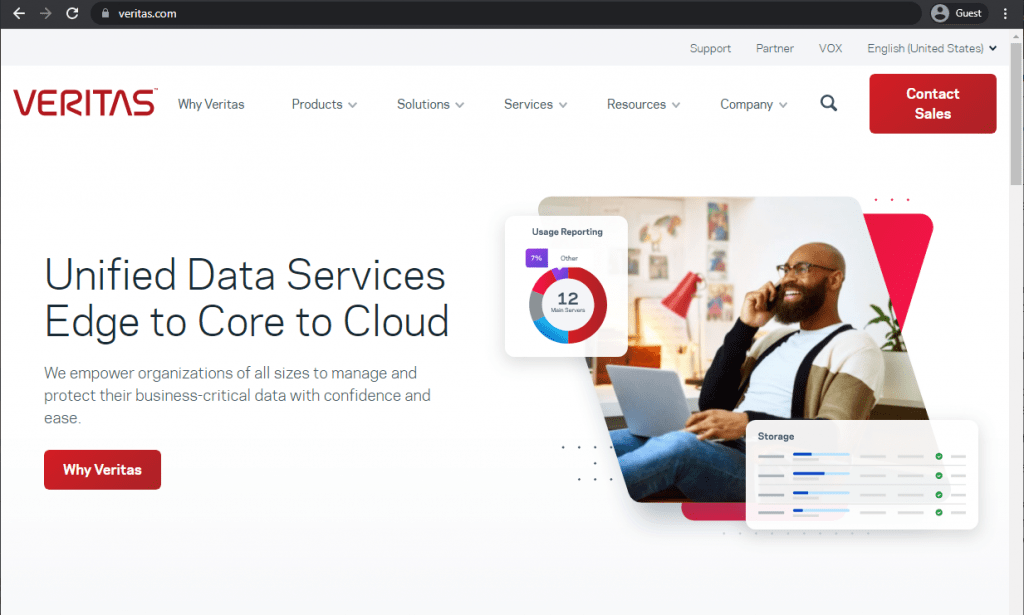
As with most of the examples on this list, Veritas is a technology company that provides tools for information governance, business continuity, storage management, as well as backup and recovery. The latter is provided via their NetBackup product – a feature-full backup and recovery solution for all kinds of workloads, from physical to virtual and even cloud storage.
Veritas NetBackup is provided inside of a converged platform that is easy to administrate, and it even supports multi-tenant setups. It also provides all kinds of features you’d expect to have in a data center backup solution – centralized management, productivity improvements, bandwidth reduction techniques, in-depth search capabilities, and so on.
Customer ratings:
- TrustRadius – 7.2/10 points based on 88 customer reviews
- G2 – 4.0/5 points based on 110 customer reviews
Advantages:
- Veritas is a highly flexible backup solution that can integrate smoothly with various cloud vendors and a diverse range of storage options.
- It offers a centralized management console that simplifies the process of monitoring multiple backup processes and other tasks simultaneously.
- Veritas is a versatile, multiplatform product that is compatible with heterogeneous operating systems, making it flexible and supportive of various environments.
Shortcomings:
- NetBackup’s interface is relatively cumbersome and tends to be far too complicated for everyone but the most experienced users.
- Both server migration and server upgrade processes are prone to failure and not exactly easy by themselves.
- Some of the more complicated or customizable backup tasks have to be initialized using the command line interface, with no alternatives.
Pricing:
- To obtain accurate pricing information for Veritas, interested individuals or organizations should contact the company directly as it does not disclose any pricing information to the public.
My personal opinion on Veritas:
Veritas is a well-established organization that has been providing data protection solutions for decades by now. It is not the most simple and intuitive software on the market, and its user interface is especially problematic. Many users face difficulties with operations such as data migration and server hardware upgrades. Additionally, some backup tasks may only be accomplished via the command line interface, which could be seen as a limitation. Lastly, it’s worth mentioning that Veritas can be a very expensive solution, even by this market’s standards.
2. Bacula Enterprise
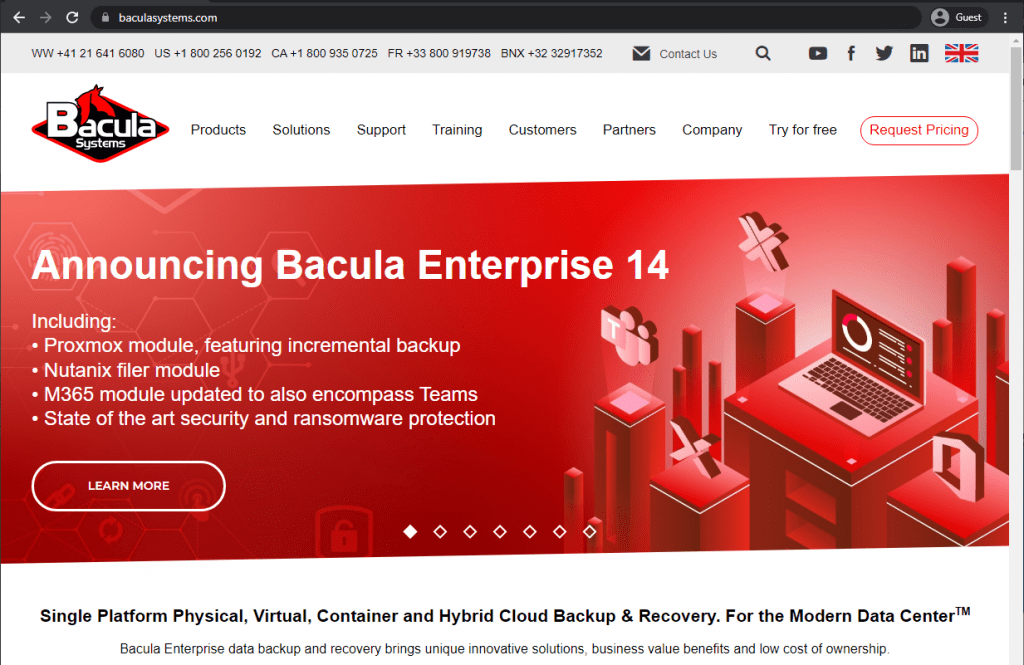
Bacula Enterprise is a comprehensive backup and recovery software solution provided by Bacula Systems. It is unique in its approach, since it can expand its own functionality within the same software – thanks to a highly secure modular system that Bacula uses to provide features like advanced backup levels, different user interfaces, deduplication and compression, advanced volume and pool management, Job Control, endpoint features such as Bare Metal Recovery for Linux and Windows systems, Client Initiated Backup, features for MSP and Hosting companies, and Snapshot technology. Bacula has support for different storage formats (including physical, public and private cloud, and practically all tape technology. As well as offering customizable protection for Microsoft 365 and other SaaS applications, it also covers containers and many different kinds of VMs and databases.
Bacula Enterprise is also exceptionally secure, flexible, customizable and scalable. When you combine it with the fact that it does not charge its users by data volume – it is understandable why it is rapidly growing in popularity with data centers, and is used by NASA, many governmental agencies, HPC environments and large ISVs. It offers automation, centralized management, permission control, advanced ransomware protection and detection tools, and many other advanced enterprise features.
Customer ratings:
- TrustRadius – 9.7/10 points based on 54 customer reviews
- G2 – 4.7/5 points based on 56 customer reviews
Advantages:
- Bacula Enterprise supports a wide range of storage types, including VMs, cloud interfaces, containers, databases, servers, and many more.
- It comes packed with numerous built-in features and capabilities, which can be further enhanced through a system of plugins.
- It is highly flexible and scalable and can be deployed in any circumstances.
- It has the ability to deal with huge throughput, which is important for the larger data centers.
- This solution has architecture and security levels that tend to go beyond that of other vendors. The system prioritizes data security and takes all necessary measures to ensure the safety of customers’ data.
- Bacula has especially rich reporting features, helping data centers to meet compliance and other regulatory requirements.
- Bacula has a wide range of deduplication technologies and techniques for different use cases.
- Bacula is a favorite among high performance computing (HPC) data centers, because if its ability to deal with billions of files and remain stable.
Shortcomings:
- Several plugins are not included in Bacula’s base package and require an additional payment.
- Although the web interface is convenient, newcomers may find it challenging due to the large number of available features. For these users, a new simplified, role-based interface is slated to be announced soon.
- Setting up Bacula for complex IT environments can take a while, which is expected given that it is designed to handle multiple technologies and provide comprehensive protection.A new installation manager has now been made available to resolve this issue.
Pricing:
- To obtain exact pricing data for Bacula, it is necessary to contact Bacula Systems directly because no public information about Bacula’s pricing is available on its official website.
- However, the website does provide some information about Bacula’s pricing model.
- There are several pricing tiers available, including:
- BSBE (Bacula Small Business Edition): Suitable for small businesses and offers BWeb, web support, up to 2 contracts and 20 agents.
- Standard: Up to 50 agents and 2 contracts. Support answer deadlines are from 1 to 4 business days.
- Bronze: Up to 200 agents and 2 contracts. Covers phone support and shorter customer support deadlines (from 6 hours to 4 days).
- Silver: Up to 500 agents and 3 contracts. Introduces a deduplication plugin and faster customer support response time (from 4 hours to 2 days).
- Gold: Up to 2000 agents and 5 contracts. The support team’s answer deadline ranges from 1 hour to 2 days.
- Platinum: Up to 5000 agents and 5 contracts. Provides PostgreSQL catalog support and one training seat per year for Administrator courses.
My personal opinion on Bacula Enterprise:
Bacula Enterprise is a truly fascinating solution in its own right. I do try my best to provide an unbiased opinion on the subject, considering my own affiliation with the software in question: Bacula has a massive number of features and capabilities it can utilize for its users – and even more features that can be added separately using a system of modules. Its security levels exceed nearly all other solutions, and it is storage agnostic, meaning that it works with plenty of storage types, ranging from classic physical storage to tapes, cloud, databases, VMs, and so on. Bacula’ts massive feature set can be considered a downside for some users, and the initial setup process may also be somewhat sophisticated for the same reason mentioned above.
3. Veeam
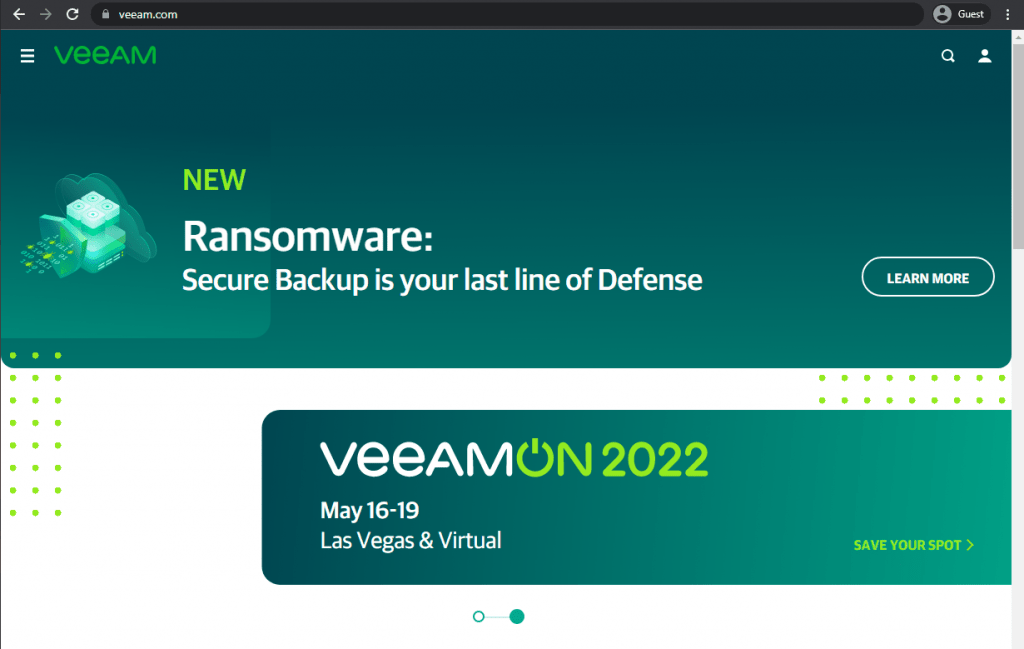
When it comes to disaster recovery for virtual environments, it’s hard to avoid mentioning Veeam Backup & Replication – a data protection solution for virtualized apps and data. It is one of the best data protection solutions on the market for Hyper-V and vSphere environments, offering comprehensive backup and recovery operations in a single platform.
Aside from free promotions for O365 Exchange Online and physical server backups, Veeam can offer a number of data center-specific features, such as key deduplication backup integration, snapshot storage integration, tape storage type support, and more.
Customer ratings:
- Capterra – 4.8/5 stars based on 69 customer reviews
- TrustRadius – 8.8/10 stars based on 1,237 customer reviews
- G2 – 4.6/5 stars based on 387 customer reviews
Advantages:
- The Veeam software offers a relatively simple first-time configuration process and a user-friendly interface for most of its basic features.
- Customer support service is another point of advantage for Veeam, it is known for providing quick and detailed responses.
- Veeam is reliable, user-friendly software with helpful customer support. In addition, there are community forums that can help address specific cases.
Shortcomings:
- While Veeam is a fairly advanced solution, its interface is somewhat outdated and may not look very modern when used alongside more recent software or operating systems like Windows 11.
- Additionally, certain areas of Veeam (data management or cyber resiliency) may not be as developed as others and could potentially be considered “blind spots.”
- Furthermore, Veeam’s pricing model is composed of multiple parts, each with its own unique pricing. However, some of these parts are significantly more expensive than others, without any apparent reason or justification.
Pricing (at time of writing):
- There is limited official information about Veeam’s pricing available on their website. To get an accurate price for the services your company requires, you need to request a personalized quote.
- However, Veeam does offer a pricing calculator page that allows users to specify the number of different environments they want covered and the planned subscription period.
- The pricing calculator page provides basic information about Veeam’s pricing, such as the ability to purchase subscriptions for at least one year and up to five years, with multi-year contracts offering additional discounts.
- The workload selection screen offers one field for each of the following workload types: Virtual VM, Cloud VM, Servers, Workstations, M365 Users, and NAS/File Shares (TB).
- If the “NAS/File Shares” field is not above zero, the “Contact Us” button will not be available. Veeam sells licenses in increments of five at a time, meaning that at least five licenses of one of the aforementioned categories must be selected.
- For instance, protecting five workloads of Virtual VM, Cloud VM, Server, or Workstation type for a year costs $642. However, the “Microsoft 365” category is an exception and requires at least ten users to be selected at once. The starting price for ten users is $306.
My personal opinion on Veeam:
Veeam is widely recognized as one of the most popular backup and recovery solutions available in the market. It offers a vast range of features and capabilities, supporting physical, virtual, cloud, and hybrid environments. It also comes with a centralized dashboard to help manage multiple backup types more efficiently. However, its security levels may not be on par with some other leading vendors in the industry, and the pricing model of the solution is extremely confusing (with little to no justification on why certain features are far more expensive than the rest). Meanwhile, Broadcom’s acquisition of VMware means many organizations are moving to other VM types, which Veeam may not be able to cater for.
4. Rubrik
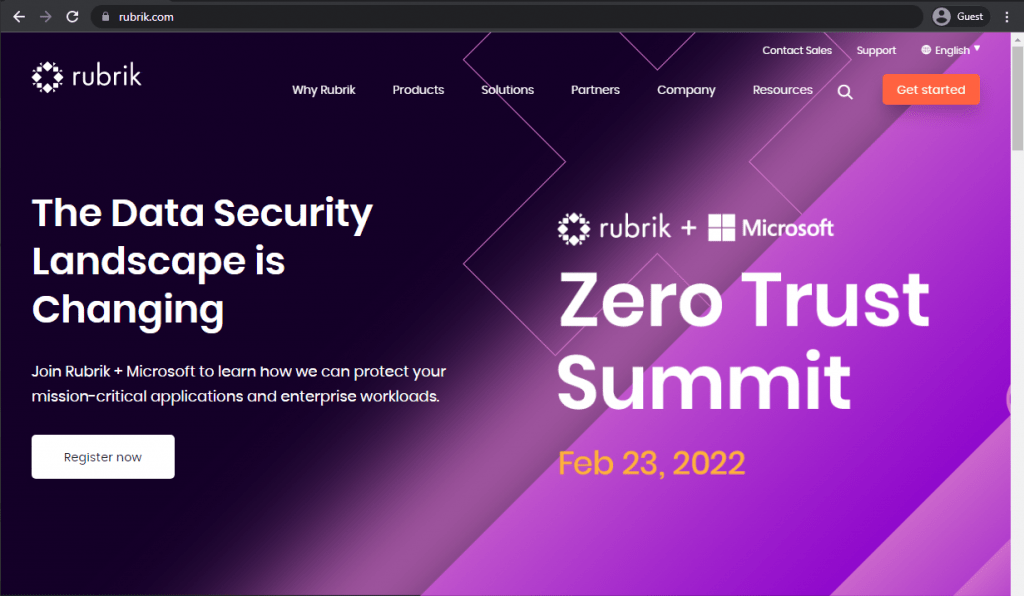
Rubrik is a well-known software platform that provides all kinds of data management features, from efficient backup and recovery operations to compliance, analytics, archival, deep search – and all of that is within a single solution for all of your data storage locations.
Rubrik’s software also works with the most popular OS, hypervisors, cloud storage providers, databases, etc. It offers a number of features aside from backup and recovery, such as extensive analytics and reporting, vast compliance and security features (ransomware protection, compliance reporting, etc.), policy-driven data management, and so on.
Customer ratings (at the time of writing):
- Capterra – 4.7/5 points based on 47 customer reviews
- TrustRadius – 8.8/10 points based on 215 customer reviews
- G2 – 4.6/5 points based on 80 customer reviews
Advantages:
- The interface of the software is relatively easy to work with.
- Plenty of different deployment types are supported, including hybrid and multi-cloud options.
- There is a big focus on automation capabilities, with many features that can be automated and customized to a certain degree.
Shortcomings:
- There is little to no internal documentation or whitepapers to go for when the purpose of a specific feature is unclear.
- Rubrik is a competent solution in its own right, but it does have a few blank spots in its feature set, such as the lack of Azure SQL backup capabilities.
- Configuring Rubrik for the first time can be a very long and drawn-out process.
- Rubrik’s security levels are up for question after recent cyber-attacks.
Pricing (at the time of writing):
- Rubrik does not provide pricing information on their official website. To obtain pricing information, one needs to contact the company directly for a personalized demo or one of the guided tours.
- Unofficial sources suggest that Rubrik has several hardware appliances, including:
- Rubrik R334 Node, which starts at $100,000 for a 3-node with 8-Core Intel processors and 36 TB of storage.
- Rubrik R344 Node, which starts at $200,000 for a 4-node with similar parameters to R334 and 48 TB of storage.
- Rubrik R500 Series Node, which starts at $115,000 for a 4-node with Intel 8-Core processors, 8×16 DIMM memory, and other features.
My personal opinion on Rubrik:
Rubrik is a backup solution that is designed to cater to the requirements of enterprises. It is equipped with a modern set of features that are suitable for backup, recovery, data management, and data protection. Its advanced policy-based management system makes it an ideal solution for companies having hybrid IT environments or other types of businesses. Unfortunately, Rubrik’s services may seem expensive for some customers, and its overall usefulness may vary depending on the client’s needs and budget constraints.
5. IBM Storage Protect
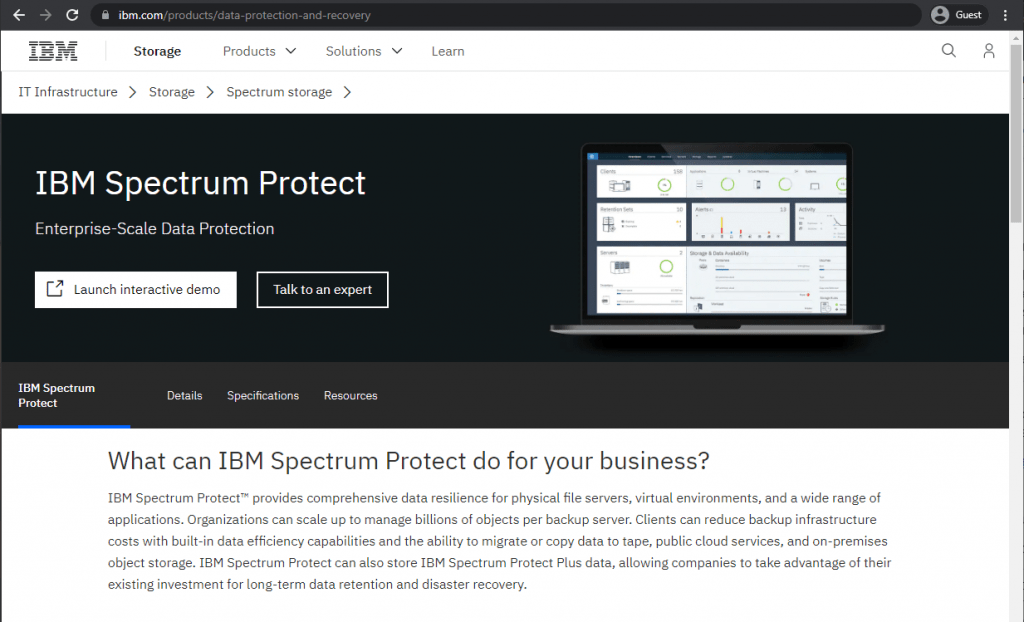
Another technological mastodont, IBM, is also capable of offering all kinds of technological services and appliances, including fields such as software development, predictive analytics, etc. Disaster recovery is also a part of this list – with their Storage Protect solution (previously known as Spectrum Protect) that offers a large list of features for backup and recovery operations, centralized data administration, and so on.
The exact list of features that IBM Storage Protect can offer is rather long, with features such as VM protection, role-based administration, backup and recovery operations for different environment types (cloud, virtual and physical), searchable catalog, among many others.
Customer ratings (at the time of writing):
- TrustRadius – 7.0/10 stars based on 41 customer reviews
- G2 – 4.1/5 stars based on 76 customer reviews
Advantages:
- Extensive documentation and logging-oriented feature set.
- Multiple data-oriented features, including security, backup, recovery, and more categories.
- Support for cloud, physical, container and hybrid deployments.
Shortcomings:
- Relatively high price for any of the solution’s capabilities.
- A steep learning curve with plenty of sophisticated features.
- The first-time configuration process is long and complicated.
- Limited VM support
Pricing (at the time of writing):
- IBM Storage Protect has no official pricing attached to it on the IBM website. However, it is possible to find information about IBM Storage Protect Plus – a software solution for backup and recovery purposes.
- The Monthly license for the solution covers up to 10 managed VMs at a time and starts at $67.70
- The Perpetual license also supports 10 managed VMs per single license and starts at $2,160.
My personal opinion on IBM Storage Protect:
IBM, traditionally known for its hardware, offers Storage Protect as a robust backup and recovery software solution for large enterprises. Its support for diverse storage types, rich feature sets, and agentless architecture make it a suitable choice. Notably, Storage Protect stands out in an area where enterprise backup solutions tend to struggle – reporting and logging capabilities. Although the initial configuration might be challenging and the overall interface could be confusing, the individual elements of IBM’s software are well-integrated, providing a surprisingly cohesive experience. However, the agentless functionality can be limited, particularly with VMware, and the tape functionality is also limited.
6. Vembu BDR Suite
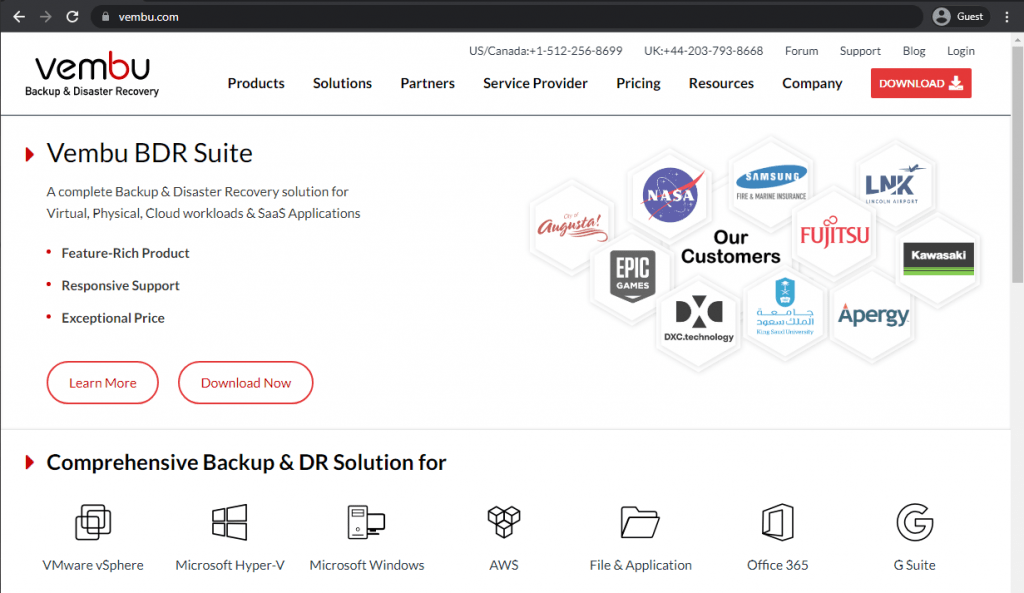
Vembu BDR Suite is a backup and recovery solution that is at its best when working with heterogeneous IT environments that includes many different parts to it. It also has both a free trial and a free version – and what’s even more surprising is that the free version is only limited with the number of VMs supported, with no limitations to the feature list.
As for the features themselves, Vembu BDR Suite has a capability to backup physical servers, virtual machines (both Hyper-V and vSphere), O365 items, SharePoint items, Exchange items, workstations, and all of that can be easily managed using a centralized user-friendly UI.
Customer ratings (at the time of writing):
- Capterra – 4.5/5 stars based on 19 customer reviews
- TrustRadius – 9.1/10 stars based on 99 customer reviews
- G2 – 4.3/5 stars based on 141 customer reviews
Advantages:
- The customer support team gathered a lot of positive reviews over the years, praising both the speed and the effectiveness of the support.
- The solution supports multiple operating systems and hardware types, including a Linux version with a complete feature set.
- The UI of the software is simple and convenient.
Shortcomings:
- Vembu’s pricing is a lot higher than most of its competition.
- While Vembu does support plenty of technologies and storage types, it does not support all of them, and there are still many different forms of storage that Vembu does not support.
- The overall feature set is vast and varied, making it difficult to understand all of the software’s capabilities at first.
Pricing (at the time of writing):
- Vembu BDR Suite’s pricing varies quite a lot depending on the target data source:
- VM Backup – from $18 per year per VM, with support for both Hyper-V and VMware deployments
- Server Backup – from $60 per year per server, both Linux and Windows servers are supported
- Application/DB Backup – from $60 per year per application/database, can work with SQL, MySQL, and Exchange
- SaaS Backup – from $12 per year per user, works for Google Workspace and Microsoft 365
- Cloud VM Backup – from $30 per year per AWS instance
- Endpoint Backup – from $15 per year per endpoint, supports Windows and Mac devices
- It’s important to mention that many of the backup solutions provided by the BDR Suite are available for free. These free solutions include most of the features but are limited in their ability to work with only a certain number of workstations, virtual machines, and servers.
- For more information about the pricing of Vembu BDR Suite and its features, you can visit the official pricing page.
My personal opinion on Vembu:
Vembu offers two solutions, BDR Suite and BDR Cloud, which are exclusively developed by the company. While BDR Cloud operates from the cloud, it is a feature-limited version of BDR Suite. Both solutions offer similar functionality, but BDR Suite is an exceptional enterprise data backup solution with an extensive range of features. It delivers impressive recovery times and responsiveness while also supporting a wide range of storage types and diverse environments. However, potential users should be aware that the solution’s complexity makes it one of the most intricate enterprise backup solutions available.
7. Dell EMC
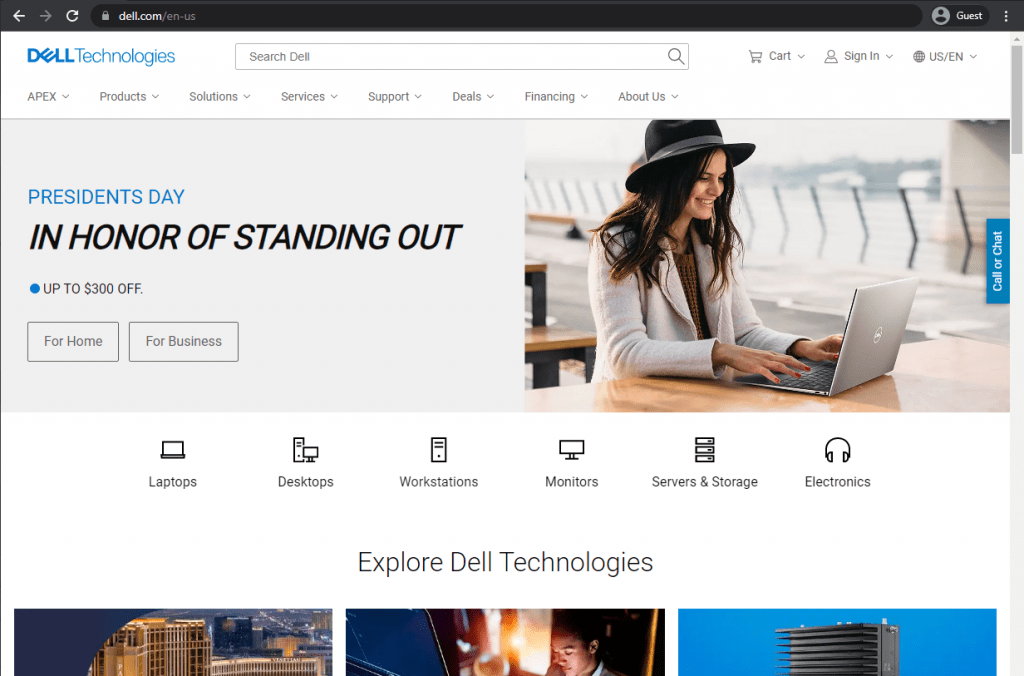
Dell EMC takes a slightly different approach to a backup and recovery solution that they’re providing – it’s a pre-packaged combination of multiple components, each of which offers a specific feature set. These solutions are Data Protection Adviser, Avamar and Networker. This kind of combination allows Dell EMC to provide a comprehensive disaster recovery suite that can work with many different environments.
Dell EMC provides physical, cloud and virtual environments with continuous availability, offering a digital transformation to a hybrid cloud infrastructure backed up by a modern infrastructure that combines storage locations, servers and other infrastructures.
Customer ratings (at the time of writing):
- TrustRadius – 7.1/10 stars based on 6 customer reviews
- G2 – 4.1/5 stars based on 20 customer reviews
Advantages:
- Impressive performance with different kinds of infrastructures, including large and complex databases.
- Support for multiple operating systems and storage types.
- The user interface of Dell’s solution is often considered relatively easy to work with.
Shortcomings:
- The overall impression of the customer support seems to range from neutral to negative.
- Self-diagnosing errors and issues is very difficult due to the lackluster information that Dell provides.
- Data recovery framework is not versatile at all, and may refuse to restore the data if the hardware configuration was changed in any way.
Pricing (at the time of writing):
- It is difficult to find any kind of official pricing information on the official website of Dell EMC. The only possible options are to request a free trial or to ask for a guided demo.
My personal opinion on Dell EMC:
Dell EMC is a capable enterprise backup solution, boasting a user-friendly interface and comprehensive centralization capabilities. Dell’s solution is fast, user-friendly, and provides plenty of centralization capabilities. It supports diverse operating systems and storage types, making it a suitable choice for large-scale businesses. However, its customer support reviews are inconsistent, and it may have slow restore times and a basic management interface.
8. Acronis
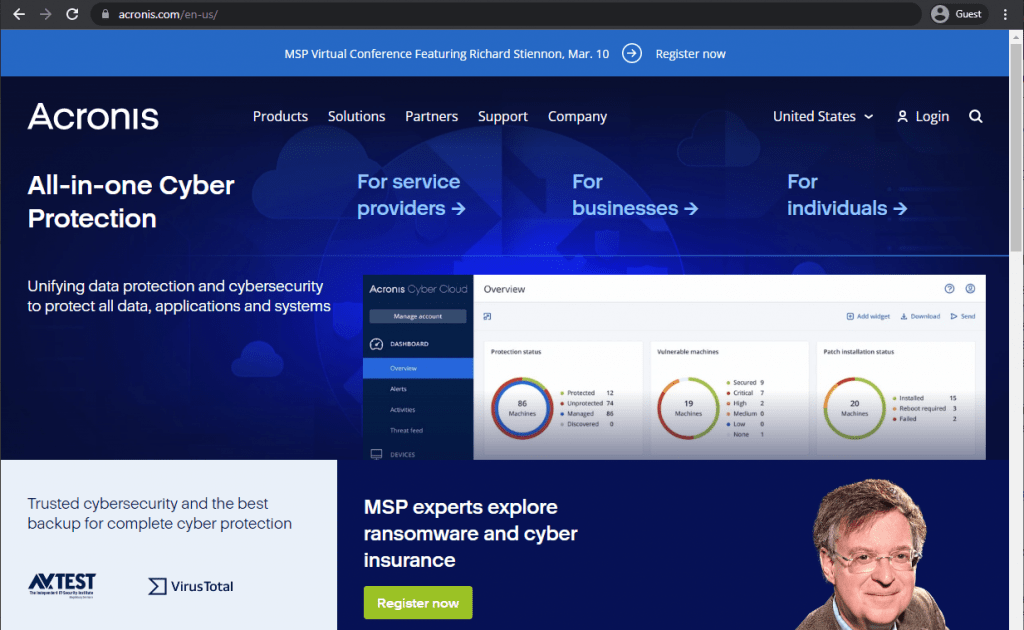
Acronis has earned its place as one of the most well-known enterprise backup solutions on the market, with their Cyber Backup software offering a multitude of features for different storage locations and devices. Since businesses these days value their data more than anything, losing said data would be a massive problem for pretty much any enterprise out there, from single servers to data centers.
Acronis Cyber Backup can help with that, offering a large number of features, including fast backup-restore operations, extensive deduplication, simple licensing for the service, administration automatization, as well as some VM support.
Customer ratings (at the time of writing):
- Capterra – 4.1/5 points comprised of 70 customer reviews
- TrustRadius – 6.8/10 points comprised of 138 customer reviews
- G2 – 4.3/5 points comprised of 670 customer reviews
Advantages:
- Data security is one of the most significant advantages of Acronis, with AI-powered malware detection, multi-layered encryption, proactive backup monitoring, and more.
- Acronis supports multiple environment types, making it possible for the software to protect many clients, regardless of their infrastructure.
- The software also offers plenty of data-gathering options, providing a lot of information that helps with proper management and monitoring of existing data assets.
Shortcomings:
- Acronis does not support many different VM types, and some other features are straight-up missing, as well, such as SalesForce backups.
- The software is surprisingly rigid, offering very limited scalability options for its clients.
- Acronis is a secure and fast data platform, but its overall data management capabilities are somewhat underwhelming, especially when compared with various competitors.
Pricing (at the time of writing):
- Acronis Cyber Protect can offer three different pricing versions — Standard, Advanced, and Backup Advanced.
- Acronis Cyber Protect Standard includes the basic feature set of the solution, Advanced adds extra features such as XenServer support, Oracle VM Server support, Acronis Notary, Acronis ASign, tape backup support, SAN storage snapshots, and more.
- The pricing for the Standard and Advanced versions is as follows:
- Workstation (physical or virtual, macOS or Windows):
- Standard: $85 per workstation
- Advanced: $129 per workstation
- Server (physical or virtual, Linux or Windows):
- Standard: $595 per server
- Advanced: $925 per server
- Virtual host (Hyper-V or VMware):
- Standard: $705 per host (unlimited VMs)
- Advanced: $1,175 per host (unlimited VMs)
- Additionally, there is a specific pricing tier available in Acronis Cyber Protect Standard. It costs $285 for one instance of Microsoft Windows Server Essentials (physical/virtual), which includes application backup.
- The pricing structure for Acronis Cyber Protect – Backup Advanced varies depending on the nature of the backup target:
- From $109 per a single workstation (Windows/macOS, virtual/physical)
- From $779 for a single server (Linux/Windows, virtual/physical)
- From $1,019 per single Hyper-V or VMware host (unlimited VMs)
- From $139 for Microsoft 365 data (SharePoint Online, Exchange Online, OneDrive for Business, Teams) or Google Workspace data (Calendar, Drive, Contacts, Gmail)
- Acronis Cyber Protect – Backup Advanced offers a broad feature range, including AD integration, image-based backups, ransomware protection, vulnerability assessment, reports, incremental/differential backups, file-level backups, group management, and more.
My personal opinion on Acronis:
Acronis is a cloud backup and cyber protection solution designed for medium to small MSPs and organizations. It provides a comprehensive approach to data protection by offering both granular file-level backup and recovery and comprehensive full-image backups. Acronis supports a wide range of platforms, ensuring seamless data protection across diverse environments, regardless of the underlying infrastructure. One of the significant advantages of Acronis is its ability to minimize disruption-induced downtime and data loss, thereby improving the overall resilience of the data protection process. However, it may face challenges in complex IT environments as it lacks compatibility with some hypervisors and databases.
9. Commvault
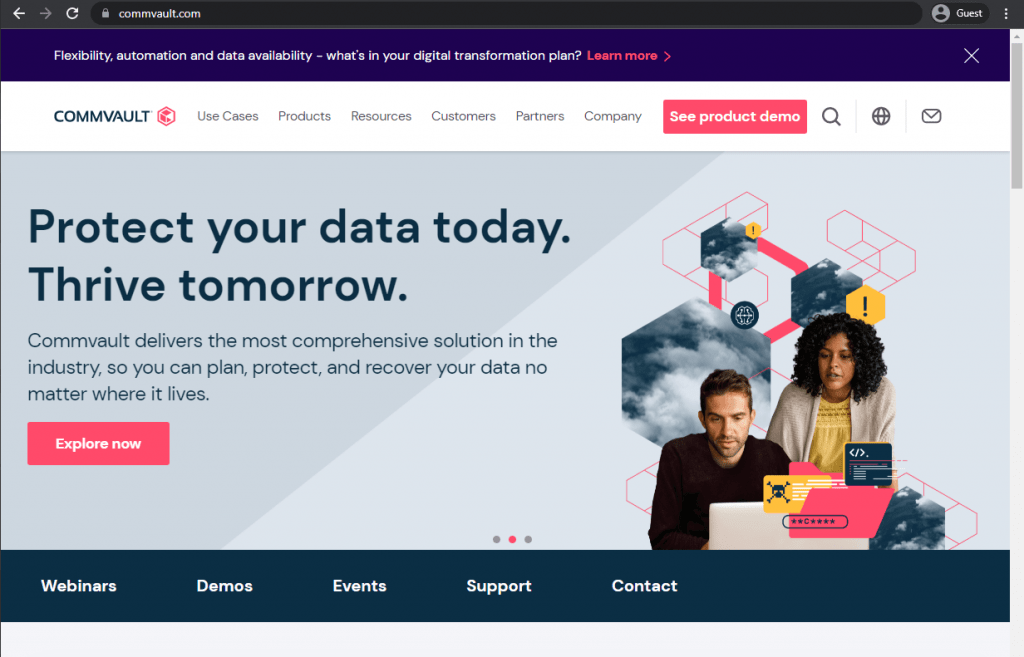
Commvault is another example of a company providing services that exceed simple backup and recovery operations by offering other data management capabilities. Instead, Commvault focuses on the combination of information management and data protection to provide its clients the ability to work with their data in an effective way.
Commvault has also partnered with many different service providers, including hypervisors, public cloud providers, as well as database protection and big data services – to be able to integrate with many other systems on the market. Commvault can also be acquired in three different forms – as a SaaS with Metallic, as an actual appliance, or as a software-only backup and recovery solution.
Customer ratings (at the time of writing):
- Capterra – 4.6/5 points based on 38 customer reviews
- TrustRadius – 8.0/10 points based on 221 customer reviews
- G2 – 4.3/5 points based on 138 customer reviews
Advantages:
- Plenty of integrations to choose from, if necessary.
- The backup configuration process is simple and straightforward.
- The software supports an overwhelming number of environment types and infrastructure configurations.
- Fairly good security levels
Shortcomings:
- A rather steep learning curve for all new users.
- An overly sophisticated first-time configuration process.
- Logging and reporting capabilities are either lacking or completely absent in most cases.
- Can get very expensive
Pricing (at the time of writing):
- Commvault does not offer any kind of pricing information to the public, the only option to receive such information is to contact the company directly.
My personal opinion on Commvault:
Commvault is a backup solution that caters to the backup needs of large enterprises. It utilizes state-of-the-art technologies to provide an outstanding user experience. The software can manage different storage options like cloud storage, VMs, databases, containers, and endpoints, and offers a fast and accurate backup and recovery experience. Although Commvault can be integrated with cloud storage providers, it can be costly. Moreover, most of its features do not include logging and reporting information, and the initial setup procedure is known to be prolonged and complex.
10. Cohesity DataProtect
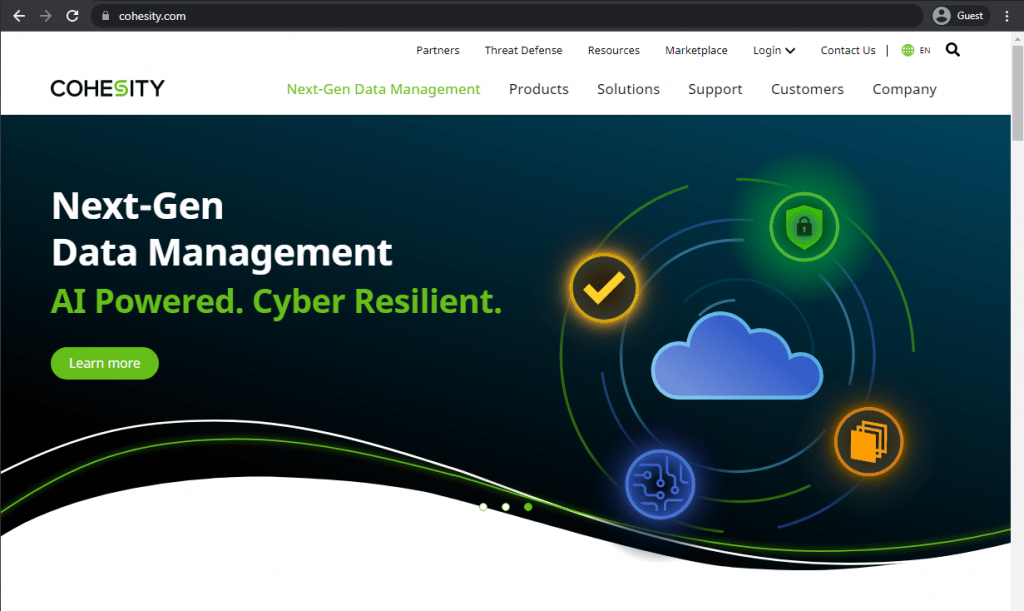
Cohesity Helios is a multifunctional platform that hosts several different software appliances, with each software covering a specific purpose. The one we are looking for here is DataProtect – Cohesity’s data protection solution that works on a software-as-a-service model.
DataProtect includes a massive list of features, including backup-as-a-service with extensive cloud security, AES-256 encryption and other means of ransomware protection, as well as multiple possibilities for consolidation and centralized data management. It also has automatization features, multiple ways to restore data from any source, extensive search functionality, and much more.
Customer ratings (at the time of writing):
- Capterra – 4.6/5 points based on 49 customer reviews
- TrustRadius – 8.3/10 points based on 81 customer reviews
- G2 – 4.4/5 points based on 47 customer reviews
Advantages:
- A relatively convenient user interface.
- The ability to offer a centralized overlook of all backed-up platforms in the form of a dashboard.
- The solution is easy to set up and configure after purchasing.
Shortcomings:
- Performing database backups with Cohesity is extremely limited.
- Some of the backup configuration options are missing, such as the ability to set a backup task at a specific date or time.
- Automation capabilities or customization tools are practically nonexistent.
Pricing (at the time of writing):
- Cohesity does not offer any kind of pricing information to the public, the only option to receive such information is to contact the company directly.
My personal opinion on Cohesity:
Cohesity is well-suited for enterprise backup needs due to its extensive range of capabilities. It can handle various types of data and storage environments, offer fast backup and restoration speeds, and provide a comprehensive list of backup-specific features. Cohesity’s infrastructure is unique with a node-like structure that facilitates rapid and effortless scalability. Moreover, the software’s interface is user-friendly, making it easier to use than other similar solutions on the market. Nevertheless, backing up databases with Cohesity can be difficult, customization is not really practical, and it requires manual intervention as there is limited automation available.
11. Carbonite Server Backup
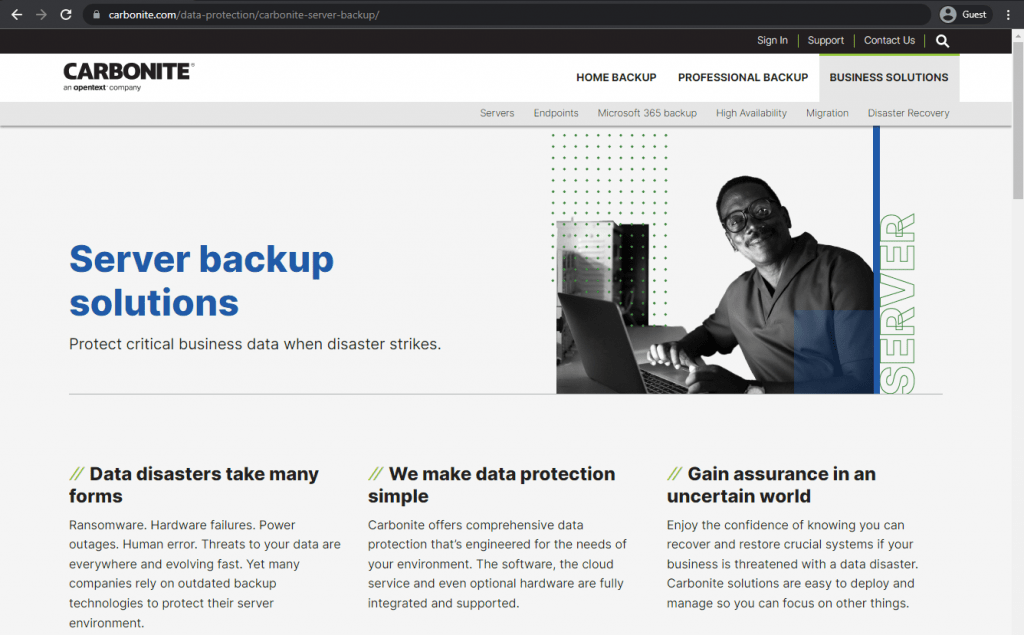
Carbonite Server Backup is a basic data center backup solution with a rather standard host of features – backup, recovery, data protection, granular restoration, support for physical, virtual and cloud storage locations, and so on. It supports multiple backup types (full, differential, incremental), as well as snapshots and can even work with hybrid backup targets.
As for some of the more unconventional options, Carbonite Server Backup supports bare metal restore, 128 bit encryption and TLS for security, offers compliance to HIPAA, GLBA and FERPA, can work with Hyper-V images, offers extensive automation capabilities, and so on.
Customer ratings (at the time of writing):
- Capterra – 4.3/5 stars based on 165 customer reviews
- TrustRadius – 8.5/10 stars based on 65 customer reviews
Advantages:
- The first-time configuration of the solution is not particularly difficult, all things considered.
- Most of the user experience with Carbonite’s software is considered praise-worthy.
- Regular backup checks for malware and ransomware are included as a baseline in the solution itself.
Shortcomings:
- Specifying files and folders as backup targets in the future is very difficult.
- The software has several unusual exceptions to its backup solution – such as the inability to back up files with the symbol “~” in their names.
- The administrative interface of the software is not responsive enough.
Pricing (at the time of writing):
- It is difficult to find any kind of official pricing information on the official website of Carbonite. The only possible options are to request a free trial or to ask for a guided demo.
My personal opinion on Carbonite:
Carbonite Backup is one of the most “normal” backup options on this list. It is a backup solution that supports multiple storage types and environment forms, including data centers. It can provide different backup types, multiple data protection options, and so on. Carbonite can offer multiple automation capabilities, support for hybrid data storage types, and complete compliance with GLBA, HIPAA, and FERPA. At the same time, Carbonite would benefit greatly from having more customization capabilities included, and its overall interface is relatively slow.
12. Barracuda Backup
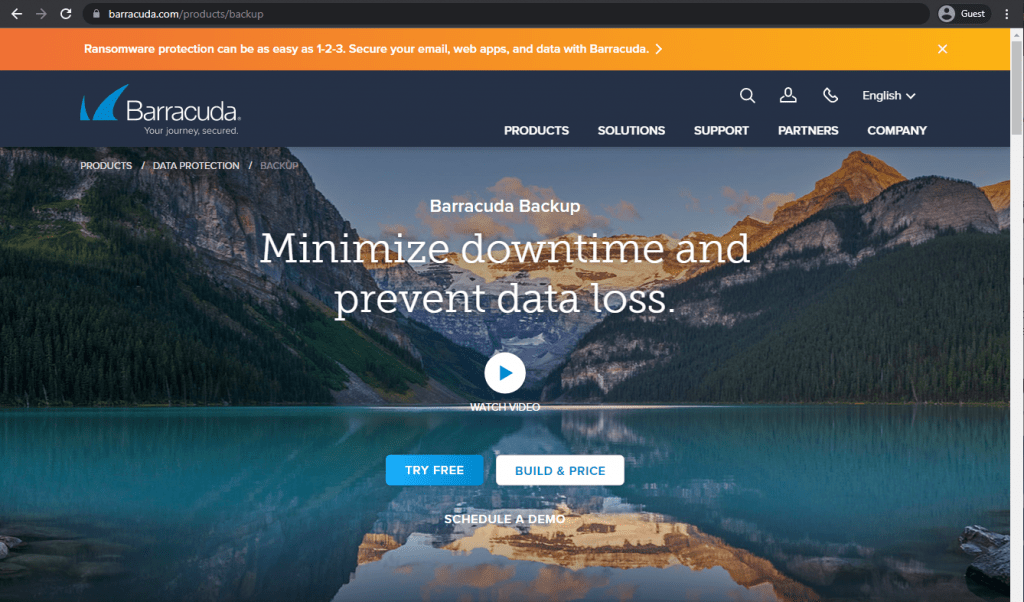
Barracuda Networks offers its own solution for backup and recovery – Barracuda Backup. It is a multifunctional data center backup solution that can back up emails, applications, as well as general data. All of the expected features, such as data encryption, centralized management and extensive deduplication, are included, as well.
Additionally, Barracuda offers pretty much unlimited cloud storage of their own, the ability to store the data off-site, near CDP, data replication, cloud-to-cloud backups, as well as Barracuda LiveBoot – the ability to instantly replace VM environments such as Hyper-V or VMware with Barracuda Cloud Storage.
Customer ratings (at the time of writing):
- TrustRadius – 7.9/10 points based on 99 customer reviews
- G2 – 4.4/5 points based on 50 customer reviews
Advantages:
- Simple and effective user interface.
- Extensive backup scheduling with plenty of customization.
- Highly customizable data retention capabilities, it is possible to set up separate retention settings for different backup sources.
Shortcomings:
- Loading the software for the first time takes a while, even after successful installation and configuration.
- The reporting capabilities are lackluster and do not have much to offer in terms of customization.
- Disaster recovery as a feature is practically nonexistent in Barracuda’s solution.
Pricing (at the time of writing):
- There is no specific public pricing available for Barracuda Backup, the only way to learn this particular information is to request a personalized quote.
- The way Barracuda collects data for such a quote is rather interesting – there is an entire configuration tool available that allows potential customers to choose from a number of options, allowing Barracuda to better understand the client’s needs.
- There are five different steps that this tool has before dropping the user to the last page with the request to “contact Barracuda to proceed”, including:
- Physical Locations – offers the ability to show how many different locations the client wants to cover, as well as the amount of raw data necessary (the basic setting is 1 location and 3TB of data)
- Deployment – the ability to choose between deployment options, there are three options to choose from: physical appliance, virtual appliance, and managed service
- Offsite Replication – an optional feature to replicate your data somewhere as an offsite storage, there is a choice between Barracuda’s own cloud, AWS, network transfer to another physical location, or no replication at all (this particular option is not recommended)
- Office 365 Backup – a short and simple choice between choosing to create backups of existing Office 365 data or to decline the option if you do not wish this data to be backed up or there is no data at all
- Support Options – a choice between three possible options, including the basic update package and the 8-to-5 customer support, an option with instant equipment replacement in case of a hardware failure and the 24/7 customer support, and a separate option for a dedicated team of engineers to be assigned to your specific company’s case
My personal opinion on Barracuda:
Barracuda’s unique approach to data backups relies on physical hardware appliances in order to perform backup tasks. The software that accompanies the hardware is not particularly difficult, and there are plenty of customization options to work with. At the same time, Barracuda has some problems with its solution, including inconsistent schedule management capabilities and lackluster tech support. The overall price of the solution is a lot higher than the market average, as well – although, Barracuda’s usage of its own hardware appliances may be one of the big factors that affect the total solution cost.
13. Asigra
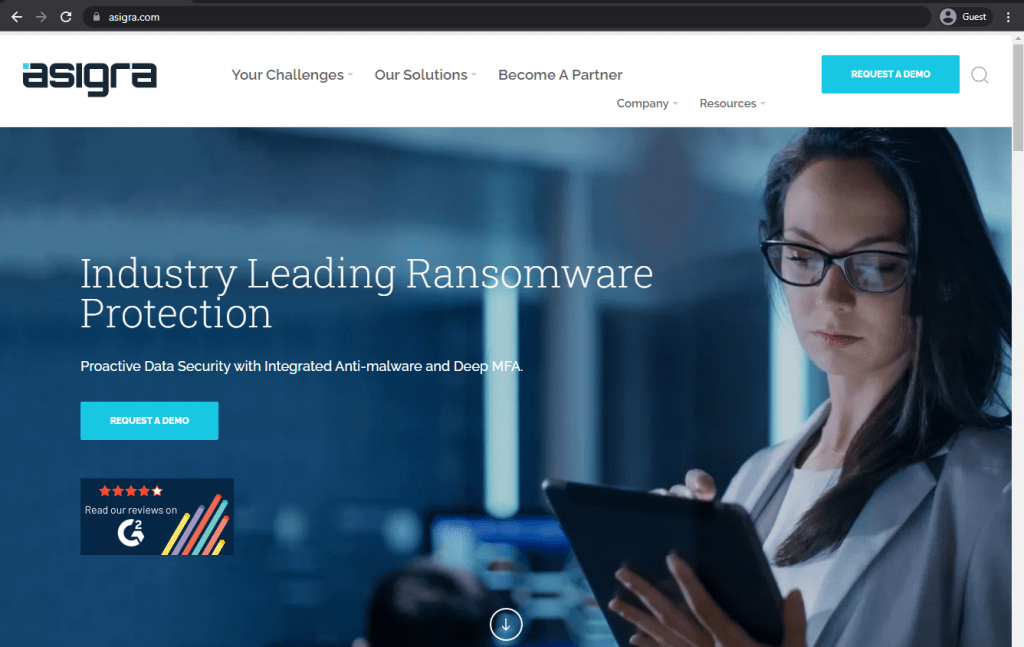
Asigra claims to be the first enterprise level agentless recovery software based in the cloud, and it has been around for over 40 years now. It provides the ability to work with all of the information types, be it applications, servers, VMs, databases, endpoint devices, etc.
Asigra provides a complete recovery assurance, helps eliminate data silos, reduces RTOs and RPOs, and also can affect the total ownership costs, as well.
Customer ratings (at the time of writing):
- TrustRadius – 6.4/10 stars based on 38 customer reviews
- G2 – 4.2/5 stars based on 82 customer reviews
Advantages:
- Data restoration tasks are easy to manage and initiate.
- Asigra’s agentless backups are incredibly convenient and work with plenty of storage types.
- Restore validation process is a fast and useful way to receive information about any existing backup.
Shortcomings:
- There is a limitation in terms of how many support calls can be made in a year.
- Asigra cannot keep up with the competition when it comes to implementing new features and improving existing ones.
- Asigra can work with many different storage types, but there is no guarantee on whether backup operations for these storage types would not interfere with each other.
- Limited scalability and technology coverage
Pricing (at the time of writing):
- It is difficult to find any kind of official pricing information on the official website of Asigra. The only possible options are to request a free trial or to ask for a guided demo.
My personal opinion on Asigra:
Asigra has been providing backup and recovery services for almost 30 years, and has undergone several rebrandings over time. Despite this, it still manages to offer a reliable level of service. Asigra is an agentless backup solution that supports endpoints, VMs, applications, and regular data storage. It has contracts with various cloud storage providers and integrates with other services to ensure the safety and accessibility of all client data. Asigra claims to eliminate data backup silos, but its feature implementation speed is slower than most competitors. A regular Asigra user is also limited in how many support calls they can make per year, which is a very unusual limitation to have.
14. N-able Cove Data Protection
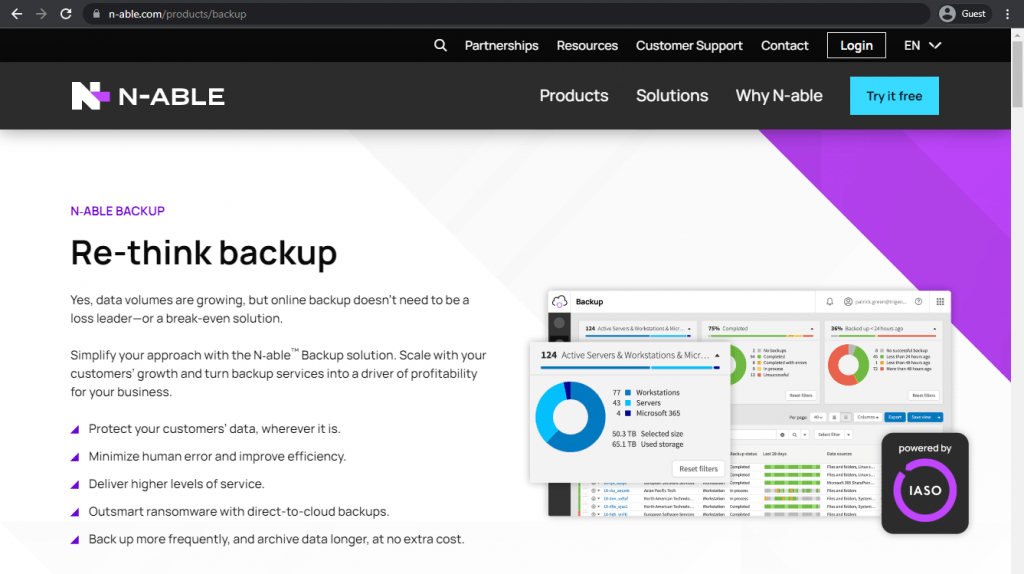
Previously known as Solarwinds Backup, N-able Cove Data Protection is a backup service for many different appliances that was built with the cloud service in mind. It can work with many different targets, from specific important documents to M365 environments, workstations, servers, and so on – with the ability to manage all of the operations using a single web dashboard.
N-able offers effective data transfer capabilities with as little bandwidth usage as possible, and can even provide its own cloud storage space with 17 data centers all over the planet. The number of recovery capabilities is also impressive, offering not just the basic recovery operation, but physical-to-cloud recovery, bare metal recovery, continuous recovery, and more.
Customer ratings (at the time of writing):
- Capterra – 4.7/5 stars based on 35 customer reviews
- TrustRadius – 8.8/10 stars based on 48 customer reviews
- G2 – 4.3/5 stars based on 228 customer reviews
Advantages:
- Vast centralization capabilities make it a lot easier to work with N-able’s solution, no matter the company size.
- N-able Cove is a relatively fast solution, and its recovery times are often above the market average.
- Cove Data Protection supports both physical and virtual storage, if necessary.
Shortcomings:
- Little to no unique or unusual features that the software can offer, making it rather hard to distinguish in a very competitive market.
- The overall logging and reporting capabilities are somewhat basic and lack customization capabilities.
- The overall number of integrations available is compensated because some of these integrations can only provide basic backup capabilities and nothing else.
Pricing (at the time of writing):
- It is challenging to find any kind of official pricing information on the official website of N-able Cove. The only possible options are to request a free trial or to ask for a guided demo.
My personal opinion on N-able:
N-able’s solution fits well between software focused exclusively on enterprise-grade clients and software incapable of scaling up from smaller companies. The software is web-based, distributed using a SaaS model, and supports physical and virtual environment types. It does not have much to offer in terms of unique features, some of the integration options are extremely basic, and the reporting customization as a whole is as bare-bones as it gets. Middle-sized companies and businesses are the prime customer category for this kind of solution.
15. MSP360
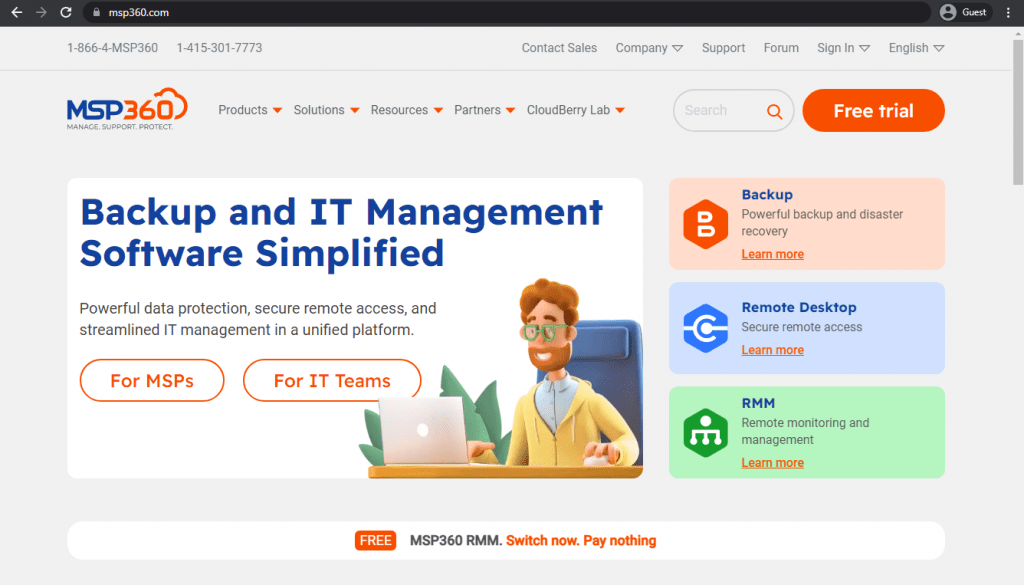
MSP360 was known for a while as CloudBerry Backup – a rather unusual backup and recovery system with plenty of different features. But its current form is just as impressive, offering backup and recovery, monitoring, centralized management, and more.
It is a massive backup platform that works with Azure, AWS, Wasabi and Backblaze B2 to provide all kinds of data protection options for users under different operating systems and appliances – M365, VMware, Hyper-V, Windows, Linux, macOS, and more.
Customer ratings (at the time of writing):
- Capterra – 4.7/5 stars based on 219 customer reviews
- TrustRadius – 7.0/10 stars based on 50 customer reviews
- G2 – 4.5/5 stars based on 479 customer reviews
Advantages:
- The software’s user interface is friendly to newcomers and can be set up with little effort.
- The overall performance of MSP360’s solution is nothing if not praise-worthy.
- Extensive centralization capabilities are also a significant advantage of MSP360, allowing for multiple tasks and operations to be controlled from the same screen.
Shortcomings:
- Some of the less-known features have a separate price tag outside of the base subscription fee.
- The solution’s customer support team does not seem to be all that effective on a consistent basis.
- MSP360 does target large businesses most of the time, which is why it is a rather expensive solution from the get-go.
- Extremely limited tech coverage which would be an issue for many data centers
Pricing (at the time of writing):
- The pricing information for MSP360 is not easily accessible on their official website. Customers must directly contact the company to receive a personalized quote.
- However, the company offers a dedicated “quote calculator” page which allows users to specify the exact components they need to back up, including Windows, Mac, Linux devices, VMware, Hyper-V, Microsoft 365, Google Workspace, and more.
- This personalized approach ensures that customers receive a tailored pricing plan based on their specific needs and requirements.
My personal opinion on MSP360:
MSP360, previously known as Cloudberry Labs, has grown from a simple backup and recovery solution into a comprehensive suite that caters to a wide range of scenarios and use cases. It includes cloud backups, physical backups, and various other features that support different operating systems while providing both granular and large-scale backup capabilities. With MSP360, an organization can have centralized control over its backup and recovery processes, ensuring seamless data protection and disaster preparedness. Although some users have mixed reviews about MSP360’s customer service, the solution’s pricing structure is flexible, allowing users to choose the features that align with their specific needs.
16. NAKIVO Backup & Replication
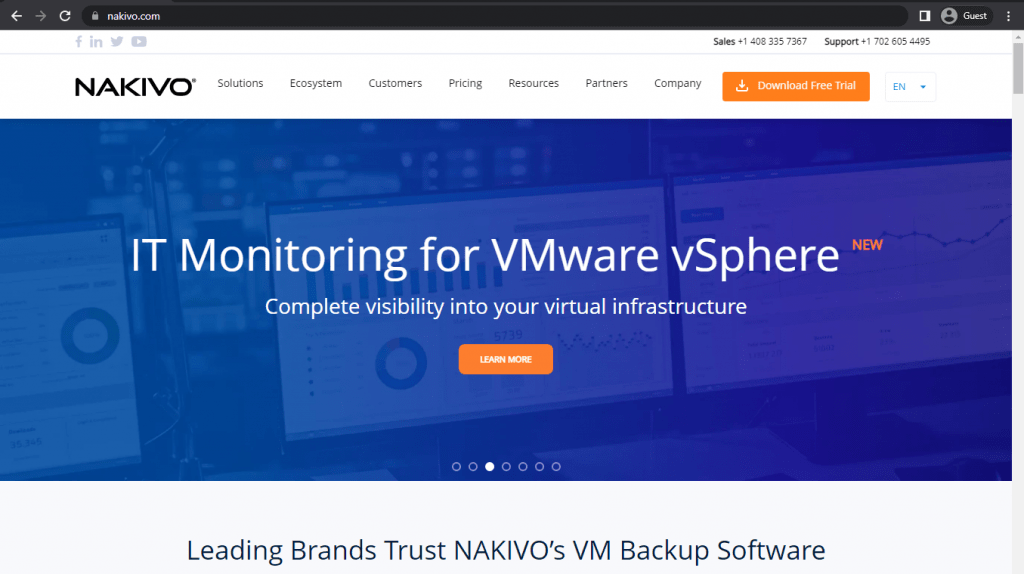
NAKIVO is another rather well-known name on the backup and recovery market, with NAKIVO Backup & Replication offering the combination of performance and reliability in a single backup and recovery solution. NAKIVO offers a multitude of different features and is capable of adapting to many different situations, including data center backup operations.
NAKIVO’s backup solution is easy to deploy using the pre-configured appliances, as well as the one-click software installers. It can protect many different target types – physical devices, virtual machines, as well as the application data (such as Microsoft 365). Its backups are fast and small, and the recovery speed is instant or near-instant, due to the usage of a variety of different techniques such as snapshots, cloud backups, and so on.
Customer ratings (at the time of writing):
- Capterra – 4.8/5 points based on 372 customer reviews
- TrustRadius – 9.1/10 points based on 170 customer reviews
- G2 – 4.7/5 points based on 217 customer reviews
Advantages:
- NAKIVO’s first-time configuration and installation is not particularly difficult, most users can perform it with minimal effort.
- The customer support experience is often regarded as one of the biggest advantages of NAKIVO, with fast response times and detailed expertise on the subject.
- NAKIVO’s user interface is convenient and easy to work with.
Shortcomings:
- NAKIVO’s target operating system is Windows, which is why Linux-based physical servers of this solution will only have a limited feature set.
- The software’s error logging is practically nonexistent and does nothing in helping the end user figure out the extent of the problem.
- NAKIVO is a rather expensive solution, and there is little justification on why the price is so high.
Pricing (at the time of writing):
- NAKIVO’s pricing can be split into two main groups:
- Subscription-based licenses:
- “Pro Essentials” – from $1.95 per month per workload, covers most common backup types such as physical, virtual, cloud and NAS, while also offering instant granular recovery, virtual and cloud replication, storage immutability, and more
- “Enterprise Essentials” – from $2.60 per month per workload, adds native backup to tape, deduplication appliance integration, backup to cloud, as well as 2FA, AD integration, calendar, data protection based on policies, etc.
- “Enterprise Plus” does not have public pricing available, it adds HTTP API integration, RBAC, Oracle backup, backup from snapshots, and other features
- There is also a subscription available for Microsoft 365 coverage that costs $0.80 per month per user with an annual billing and can create backups of MS Teams, SharePoint Online, Exchange Online, OneDrive for Business, and more
- Another subscription from NAKIVO is its VMware monitoring capabilitiy that comes in three different forms:
- “Pro Essentials” for $0.90 per month per workload with CPU, RAM, disk usage monitoring and a built-in live chat
- “Enterprise Essentials” for $1.15 per month per workload that adds AD integration, 2FA capability, multi-tenant deployment, and more
- “Enterprise Plus” with no public pricing that adds RBAC and HTTP API integrations
- Perpetual licenses:
- Virtual environments:
- “Pro Essentials” for $229 per socket, covers Hyper-V, VMware, Nutanix AHV, and features such as instant granular recovery, immutable storage, cross-platform recovery, etc.
- “Enterprise Essentials” for $329 per socket, adds native backup to tape, backup to cloud, deduplication, 2FA, AD integration, and more
- “Enterprise Plus” with no public pricing that adds RBAC and HTTP API integrations, as well as backup from storage snapshots
- Servers:
- “Pro Essentials” for $58 per server, covers Windows and Linux, and features such as immutable storage, instant P2V, instant granular recovery, etc.
- “Enterprise Essentials” for $329 per server, adds native backup to tape, backup to cloud, deduplication, 2FA, AD integration, and more
- “Enterprise Plus” with no public pricing that adds RBAC and HTTP API integrations
- Workstations:
- “Pro Essentials” for $19 per workstation, covers Windows and Linux, and features such as immutable storage, instant P2V, instant granular recovery, etc.
- “Enterprise Essentials” for $25 per workstation, adds native backup to tape, backup to cloud, deduplication, 2FA, AD integration, and more
- “Enterprise Plus” with no public pricing that adds RBAC and HTTP API integrations
- NAS:
- “Pro Essentials” for $149 per one Terabyte of data, can backup NFS shares, SMB shares, folders on shares, and offer file level recovery
- “Enterprise Essentials” for $199 per one Terabyte of data, adds AD integration, 2FA support, calendar, multi-tenant deployment, etc.
- “Enterprise Plus” with no public pricing that adds RBAC and HTTP API integrations
- Oracle DB:
- “Enterprise Plus” is the only option available for Oracle database backups via RMAN, it can offer advanced scheduling, centralized management, and more
- VMware monitoring:
- “Pro Essentials” for $100 per socket with CPU, RAM, disk usage monitoring and a built-in live chat
- “Enterprise Essentials” for $150 per socket that adds AD integration, 2FA capability, multi-tenant deployment, and more
- “Enterprise Plus” with no public pricing that adds RBAC and HTTP API integrations
- Virtual environments:
My personal opinion on NAKIVO:
NAKIVO is a great backup and recovery solution that fits many different use cases. It can be configured with little to no issues whatsoever, its performance is impressive, and the customer support excels in both response times and effectiveness. NAKIVO is not the oldest solution on this market, and it does not have more features than its competitors. However, none of these factors make it a bad software offering by default. Albeit, it would be wise to mention to any potential customer that NAKIVO’s capabilities in terms of logging and reporting are very lackluster, and its pricing is on the more expensive side for the most part.
17. HPE StoreOnce
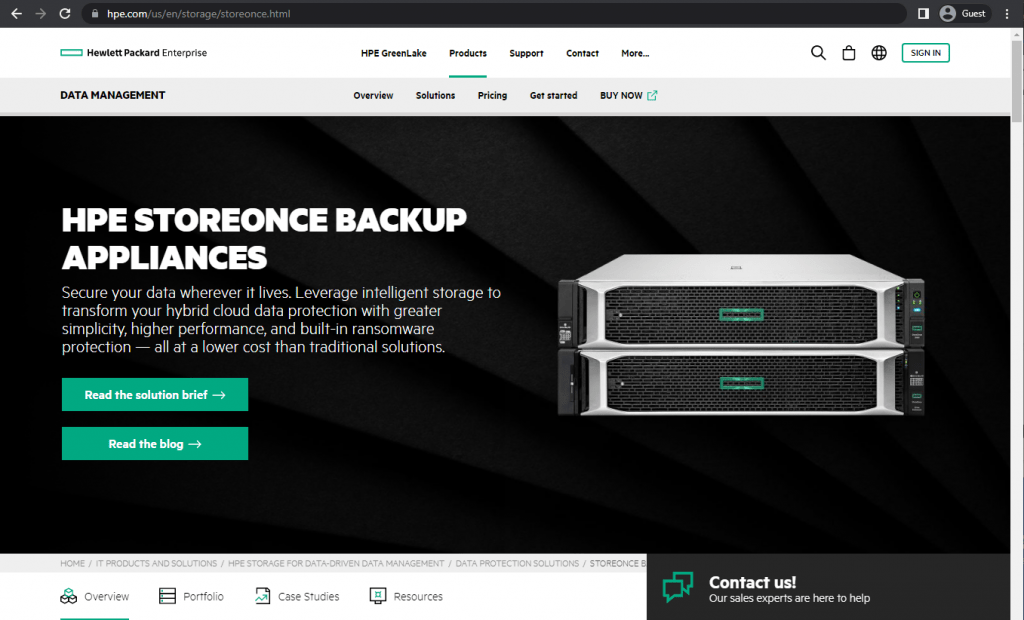
HPE StoreOnce is a slightly different take on the same subject – it is a backup and recovery solution by Hewlett-Packard Enterprise, with its biggest difference being the fact that it is an actual piece of hardware, a physical appliance that offers features such as deduplication, disk-based backups, as well as long-term data storage.
StoreOnce is capable of working with the companies of all sizes, from small businesses to large enterprises, and it also has many useful features, such as the support for different types of environment, capability to monitor backup processes for multiple systems, as well as a host of advanced features for its integration with other HPE products – such as 3PAR, Nimble and Primera.
Customer ratings (at the time of writing):
- TrustRadius – 9.2/10 points based on 15 customer reviews
- G2 – 4.4/5 points based on 6 customer reviews
Advantages:
- Support for several different storage protocols, including NAS, VTL, and even Catalyst – HPE’s own proprietary storage protocol.
- Plenty of integrations to choose from, including multiple backup solutions.
- Extensive data deduplication capabilities, offering a drastic reduction in total storage space that backups take.
Shortcomings:
- The deduplication process, while useful, is also resource-intensive, creating a significant load on a customer’s hardware each time that happens.
- Using HPE’s solution makes it very difficult to use other solutions that are not produced by HPE, limiting the overall flexibility of the end user.
- Implementing HPE StoreOnce is also a resouce-intensive process in terms of finances, since purchasing both the software and the hardware requires a significant up-front investment.
Pricing (at the time of writing):
- It is difficult to find any kind of official pricing information on the official website of HPE StoreOnce. The only possible options are to request a free trial or to ask for a guided demo.
My personal opinion on HPE StoreOnce:
HPE StoreOnce offers another backup solution for data centers and other large clients that rely a lot on actual physical hardware to perform most of its backup and storage operations. It is a versatile option with plenty of capabilities by default. It also has its fair share of issues, including the possibility of a vendor lock, the overall implementation price, and the resource-intensiveness of the deduplication solution.
18. Micro Focus Data Protector
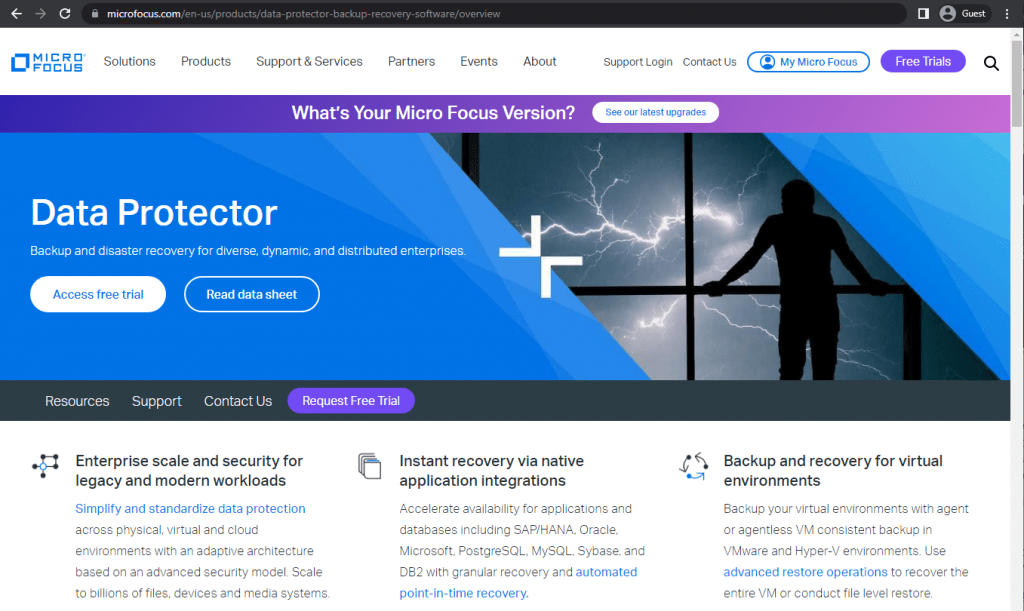
Micro Focus Data Protector is a backup and recovery software that was acquired from HPE. It offers a high level of security, extensive backup and recovery features, as well as monitoring, automation, and other features. Its architecture is partially adaptive, capable of scaling itself to different levels depending on the needs of a client.
The range of existing features of Micro Focus Data Protector is rather impressive, including instant recovery capabilities with a lot of different applications and database types (via app integrations), as well as scalability, cloud backup, support for virtual environments such as VMware and Hyper-V. There is also the capability to track and manage key performance indicators of your backups, as well as the automated disaster recovery system with the bare metal recovery support for your data center backup efforts.
Key features:
- Support for both agentless and agent-based deployments.
- Multiple useful features, such as granular recovery, data compression, data deduplication, and management centralization.
- Several security features, such as encryption and many others.
- Plenty of storage types are supported by the solution.
Pricing (at the time of writing):
- It is difficult to find any kind of official pricing information on the official website of Micro Focus Data Protector. The only possible options are to request a free trial or to ask for a guided demo.
My personal opinion on Micro Focus:
Micro Focus is a backup and recovery solution that focuses most of its efforts on enterprise-grade clientele. It supports a multitude of IT environments and storage types, providing backup, recovery, and security capabilities to its clients. It can be deployed as both agentless and agent-based solution, it has centralization capabilities, and its reporting capabilities are also far better than what most of the market has to offer.
19. Quest Rapid Recovery
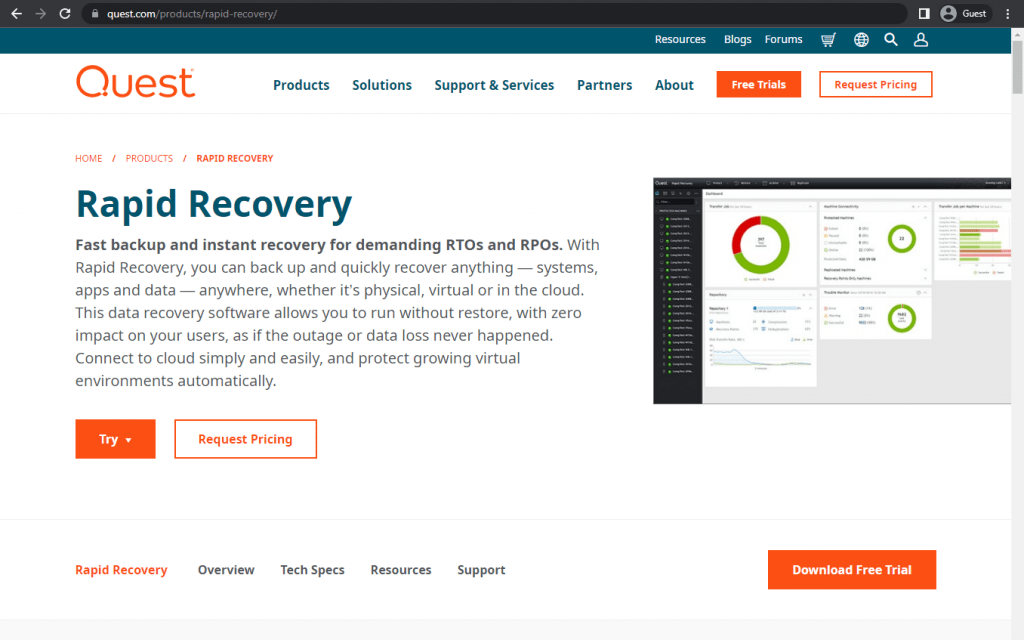
Quest Rapid Recovery is a backup and restore software provided by Dell that provides an abundance of features to its clients in terms of both backup and restore operations. It has a centralized management console, supports plenty of different applications, and has a variety of different cloud storage providers to choose from, provided by a disaster-recovery-as-a-service model.
Quest Rapid Recovery works with even the most demanding RPOs for your data center backup purposes via performing image-based snapshots as often as every 5 minutes, and it can also speed up restoration times with its Rapid Recovery feature. Additionally, there are protection measures for both virtual and physical environments, support for both data replication and data deduplication, and more.
Customer ratings (at the time of writing):
- Capterra – 4.7/5 stars based on 6 customer reviews
- TrustRadius – 7.1/10 stars based on 32 customer reviews
- G2 – 4.0/5 stars based on 41 customer reviews
Advantages:
- Quest’s interface is very simple and user-friendly, making it possible for even the most non-experienced users to work with it.
- The customer support team of Quest gathered plenty of positive reviews over the years, citing its usefulness and response speed.
- The average weight of a Quest backup can be drastically reduced with a combination of deduplication and other features.
Shortcomings:
- Quest Rapid Recovery is a versatile and responsive solution, but its overall feature set would not be able to satisfy the needs of most enterprise-level customers.
- The overall data recovery time seems to be surprisingly slow, considering how the solution itself is called “Rapid Recovery”.
- Quest does not have much to offer when it comes to training materials and documentation about the solution.
Pricing (at the time of writing):
- It is difficult to find any kind of official pricing information on the official website of Quest Rapid Recovery. The only possible options are to request a free trial or to ask for a guided demo.
My personal opinion on Quest Rapid Recovery:
Quest Rapid Recovery is a backup tool that was developed by Quest Software. Previously, Quest Software was a division of Dell before it was separated into its current form as a standalone enterprise software provider. Rapid Recovery is the company’s most significant offering that supports multiple platforms, including Windows and several Linux distributions. The tool in question can also copy data from VMs and cloud storage, among other sources. Additionally, the solution is relatively user-friendly and web-based, which makes it more versatile than most of the competition.
20. Percona XtraBackup
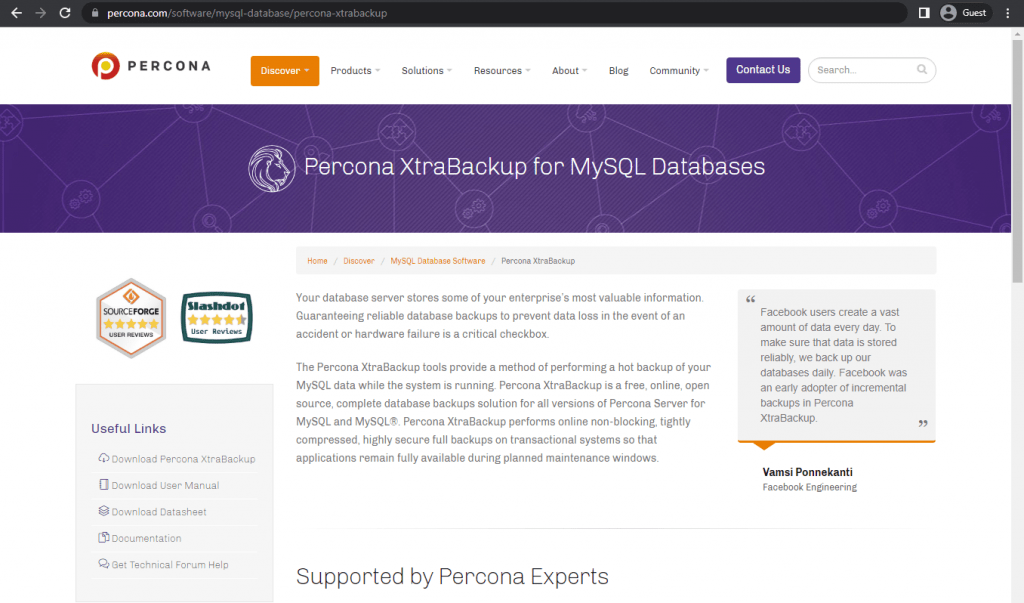
Another unusual participant of the list is Percona XtraBackup – an open source backup solution that is free and is capable of working with app versions of Percona server. It provides fast and reliable backups while saving both network bandwidth and disk space by using technologies such as compression, and it can also verify its backups automatically.
Percona XtraBackup is capable of creating backups for HailDB, InnoDB and XtraDB, among others, without interrupting the applications themselves and producing long downtimes. There is also the ability to perform incremental, compressed and streaming MySQL backups, as well as MariaDB support and many other advantages for database owners.
Customer ratings (at the time of writing):
- Capterra – 4.8/5 stars based on 14 customer reviews
- TrustRadius – 8.8/10 stars based on 4 customer reviews
- G2 – 4.8/5 stars based on 6 customer reviews
Advantages:
- Plenty of features to choose from, including parallel backups, hot backups, incremental backups, multithreading, and more.
- The capability to save backups to cloud storage is included by default.
- The overall performance of the solution is impressive, to say the least, and there is also no need to lock databases before performing database backups, either.
Shortcomings:
- It cannot work with many different database types.
- There is no dedicated GUI to work with.
- Configuring XtraBackup for the first time can be a long and arduous process.
Pricing (at the time of writing):
- Percona XtraBackup is an open-source solution that is completely free.
My personal opinion on Percona:
Percona is a rather interesting solution for this specific list. Its price tag alone is enough to make it different from the rest, and its overall efficiency is nothing short of impressive. At the same time, the lack of any kind of comprehensive customer support team makes it difficult to work with such a solution with no prior experience, and the overall focus on databases makes it a solution with an extremely narrow set of use cases by default.
Conclusion
Data center backup is a matter of great importance for nearly all enterprises, and it is also something that one should not try to overly reduce costs on, since it basically safeguards your entire business as a whole. Picking a specific data center backup solution is not necessarily easy, which is why we have tried to help by presenting our top 20 data center backup solutions for different enterprises and use cases.
Frequently Asked Questions on the topic of Data Center Backups
What is the strategy for choosing the correct data center backup solution for a specific use case?
Plenty of different factors go into choosing the backup solution for data centers. Security levels are obviously a main factor, especially in the last couple of years. Some additional important factors are scalability, data volume capability and pricing models,, data sensitivity, Recovery Time Objectives, Recovery Point Objectives, and even data types. Technology fit, scalability and customizability are typically overridingly important factors for the larger data centers. It is highly recommended to evaluate multiple different solutions for this kind of use case, since most data centers are objects of critical importance and should have an appropriate level of security and protection.
What is the impact of data center backups on the overall system performance?
While there are plenty of different features and methods that are used to ensure there is little to no effect from the backup operations on the overall hardware of a data center, it is still highly recommended to perform larger and more complex backup operations outside of the high-traffic portions of the day. If a large-scale (full) backup is launched in the middle of the day, there may well be a moderate potential for a partial system slowdown due to the sheer amount of information data centers work with.
What is the recommended backup frequency for data centers specifically?
There is no single answer to this question since data backup frequency depends a lot on the importance and dynamism of the data itself. Some of the more sensitive information needs to be backed up one or more times a day, while the majority of information can stick to the daily or weekly backup schedule.


